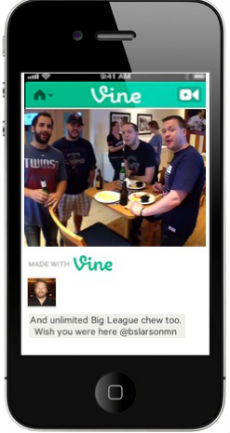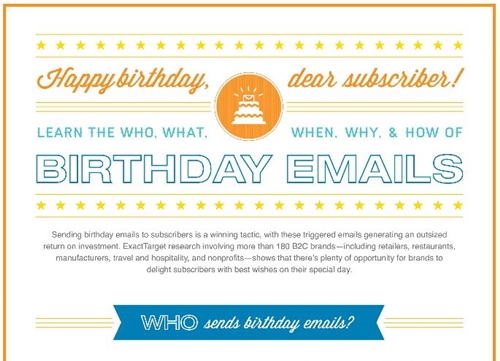50 Powerful Statistics About Tech Mega Trends Affecting Every Business – There are five mega trends impacting the IT departments of every company: Mobile, Social, Cloud, Apps and Big Data. In this presentation, Vala Afshar reveals ten startling stats for each mega trend. @ValaAfshar
Oracle Buys Compendium, A Content Marketing Startup, To Build Up Its Arsenal Against Salesforce - Congratulations to Chris Baggott, founder of Compendium (and Exact Target) on the aquisition by Oracle, which also aquired Eloqua late 2012. The cloud markting space is heating up!
TechCrunch
2014 B2C Content Marketing Research – 60% of B2C marketers expect their company's content marketing budget to increase over the next 12 months. Learn about more trends here.
Content Marketing Institute
Associated Press is the Latest News Organization to Try Sponsored Content – The roll out is expected in early 2014, with potential sponsorship deals centered around major events the AP is planning to cover, such as the Super Bowl, the Winter Olympics and the Academy Awards.
AdAge
What Can We Expect From The Next Decade of Marketing? – Like it or not, we've entered a post-promotional paradigm. Marketers must focus on experiences, adaptive strategy and platforms that hold customers' attention.
Forbes
The Evolution of Content Marketing Software – Becoming a full-fledged segment was the result of a steep climb over fast-changing buyer behaviors and technology providers adapting to those shifts. Check out this great horizontal infographic chronicling this evolution from 1993 to present.
Kapost
Google Tests Banner-Like Ads in Search Results – Google confirmed that it has been experimenting with these visual search ads among a select group of desktop users in the United States, but in a very limited test in the U.S.
Mashable
Twitter Experiments With a Private Feed – Opting in to the experiments involves following two special Twitter accounts, which then send personalized messages using the service's direct message function. The experiments may provide a preview of how Twitter will further expand a service that started out simple but is now becoming more complex. Follow @MagicRecs and @eventparrot to experience it yourself.
MIT Technology Review
Twitter Now Offers Tweet Scheduling Function for Advertisers – Many marketers use third-party social media dashboards to schedule their tweets ahead of time. But Twitter advertisers may be able to give those tools a rest with Twitter's new scheduled tweets option.
ClickZ
3 Hashtag Tools That Rock – This technology blogger reviewed three sweet hashtag tools, complete with screenshots, tips, and some practical takeaways. A must read for anyone wanting to improve visibility among influencers on Twitter.
SteamFeed
Study: New Algorithm Can Spot the Bots in Your Twitter Feed – Borrowing some tricks from computational neuroscience, coauthors Gabriela Tavares and Aldo Faisal have come up with an algorithm that can tell—with 85 percent accuracy—whether a Twitter account is home to a bot or (worse) a corporate shill instead of a regular person.
Wired
Study: Facebook Ad Profit a Staggering 1,790% More on iPhone than Android – More than 200 billion ads on Facebook says that mobile ads on iPhone generate 1,790 percent more return on investment than ads on Android. Even worse, advertising on Android actually costs more than it returns.
Venture Beat
Study: New Algorithm Can Spot the Bots in Your Twitter Feed – Borrowing some tricks from computational neuroscience, coauthors Gabriela Tavares and Aldo Faisal have come up with an algorithm that can tell—with 85 percent accuracy—whether a Twitter account is home to a bot or (worse) a corporate shill instead of a regular person.
Wired
6 Seasonal Christmas Email Marketing Ideas – ‘Tis the season for marketing, so this is an ideal time to be planning your holiday promotions. Online retailers in particular can benefit from strategically planned cross-channel sales promotions.
SUREFIRE Blog
Report: Google+ Drives a Fraction of the Referral Traffic That Facebook, Pinterest & Twitter Do – According to Shareaholic, Google+ has consistently driven less than one-tenth of one percent (> 0.1%) of all referral traffic to its publishers over the past year. Statistics suggest that Google+ usage continues to grow, but critics point out that those numbers are "goosed" to some degree because Google has integrated Google+ features across its properties and activity on other properties can count as being "active" on Google+, too.
Marketing Land
Millennials Want Technology to Invade Their Lives More Deeply – The survey of
12,000 people aged 18 and older in eight countries, commissioned by Intel Corporation, showed that 18- to 24-year-olds want technology to be more personal and know their habits, but also think technology makes people less human. Older women and those living in emerging markets are the most enthusiastic about the role technology can play in their lives. Are you optimized for that?
The Globe & Mail
Study: Facebook Delivering 152% ROI for Retailers in 2013 – E-commerce may not have taken off on Facebook, but a new study suggests that retailers can still use the social network to drive sales.
Online Media Daily
41 Redundancies You Should Ditch – Have your ever experienced editor's block? Read this list of redundancies to cure you of these copy writing gaffes. The comments are worth a look too.
Ragan's PR Daily
Google Launches New Google Media Tools Site for Journalists – Whether it's refining your advanced search capabilities, improving audience engagement through Google+, or learning how to visualize data using Google Maps, this website is intended to guide you through all the resources Google offers to journalists.
Google
Think Social Media Is a Waste of Time? Don’t Give Up So Soon – Before you rush to judgment, give your effort an honest assessment against the following three basic criteria of effective social media.
Marketing Profs
Facebook Announces New "Stories To Share" Feature For Media Sites & Publishers – Stories to Share makes it even easier for media sites to find the most engaging content they might want to post on Facebook. Publishers can now easily post any of those suggestions to their page directly from their Insights Dashboard in their admin panel. This is currently a test starting with media organizations and publishers and is not available on all Pages.
Facebook
A Marketer's Guide to iBeacons and Bluetooth Low Energy –
By combining the use of mobile apps and location-based services, marketers are able to reach out to their customers in the right place and at the right time to help increase engagement and drive conversions. Learn how here.
eConsultancy
3 Analytic Tools to Improve Your Social Media Performance – It's important to analyze your social media efforts and try to improve results. These tools can help you do just that.
SocialMedia Examiner
7 Big Recent Twitter Changes You Should Know About to Optimize Your Tweeting – The communication dynamics happening on Twitter could drastically change how customer support interacts with followers and the ability to direct message anyone will increase the velocity of newsworthy exchanges with PR and marketing pros.
Buffer
From the Online Community
From "
Digital Marketing Has Changed; What Are You Doing About It?,"
Luke Collins said, I agree that it is a necessity to use the right tools in order to reach customers, but it is no longer just about providing information regarding products and services, it is also about engaging in a conversation. Social media provides an opportunity to have a give and take between you and those that you are trying to reach. By producing content that encourages dialogue you are much more likely to get customers actively involved in your campaign.
From "
8 Things You Need to Know About Influencer Marketing,"
Ted Atwood said, Blogs are a great opportunity to share content – decentralize the control news papers and media outlets have on content and expose all angles of a story. Great way to define the science behind the success.
What's Your Take?
Have you been optimizing your Twitter feed? Are you optimizing for the Millennial Generation? Are you harnessing the power of mobile apps to engage with your customers at the right time and the right place? I guess we’re just in an “optimized” state of mind this week.
Thanks for reading and have a great weekend!
Photo credit: Shutterstock








